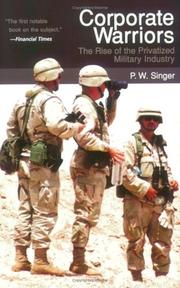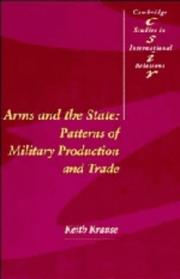| Listing 1 - 10 of 22 | << page >> |
Sort by
|
Book
ISBN: 906256755X Year: 1989 Publisher: Amsterdam Free university Amsterdam
Abstract | Keywords | Export | Availability | Bookmark
 Loading...
Loading...Choose an application
- Reference Manager
- EndNote
- RefWorks (Direct export to RefWorks)
Polemology --- ontwapening --- Nuclear arms control --- Non-provocative defense (Military science) --- 355.019 --- 355.02 --- Non-offensive defense (Military science) --- Reactive defense (Military science) --- Structural incapacity for attack (Military science) --- Deterrence (Strategy) --- Nuclear weapons control --- Arms control --- Nuclear weapons --- Nuclear arms control. --- Non-provocative defense (Military science).
Book
ISBN: 9063030061 Year: 1977 Publisher: Antwerpen Kritak
Abstract | Keywords | Export | Availability | Bookmark
 Loading...
Loading...Choose an application
- Reference Manager
- EndNote
- RefWorks (Direct export to RefWorks)
Science --- Polemology --- Belgium --- 355 <493> --- Military research --- -#BUAR:bibl.de Bock --- 810 Theorie en Methode --- 837 Financiën en Bankwezen --- 841.5 Bestuur en beleid --- 875 Defensiegerelateerde industrie --- 875.1 Onderzoek en ontwikkeling --- 884.4 West-Europa --- Defense research --- Research --- Research and development contracts, Government --- Defensie. Krijgskunst. Landsverdediging. Strijdkrachten. Krijgskunde--België --- 355 <493> Defensie. Krijgskunst. Landsverdediging. Strijdkrachten. Krijgskunde--België --- #BUAR:bibl.de Bock

ISBN: 2870277962 9782870277966 Year: 2000 Volume: 246-248 Publisher: Bruxelles: GRIP,
Abstract | Keywords | Export | Availability | Bookmark
 Loading...
Loading...Choose an application
- Reference Manager
- EndNote
- RefWorks (Direct export to RefWorks)
Peaceful change (International relations) --- Transformations pacifiques (Relations internationales) --- 327.36 --- 355.019 --- 355.019Vredesonderzoek: algemeen --- Médiation internationale --- Academic collection --- #SBIB:327.5H20 --- #SBIB:013.AANKOOP --- Vredesonderzoek: algemeen --- International movements --- Development aid. Development cooperation --- Law of armed conflicts. Humanitarian law --- Gestion des conflits --- Paix --- Peace --- International relations --- Mediation, International --- Relations internationales
Book
ISBN: 9002206798 9789002206795 Year: 1998 Publisher: Antwerpen Icarus
Abstract | Keywords | Export | Availability | Bookmark
 Loading...
Loading...Choose an application
- Reference Manager
- EndNote
- RefWorks (Direct export to RefWorks)
Internal politics --- mensenrechten --- Rwanda --- Afrika --- Afrique --- Anthropologie socio-culturelle --- Gerecht --- Guerres --- Justice --- Oorlogen --- Politiek --- Politique --- Socio-culturele antropologie --- #BUAR:bibl.de Bock --- 355.426 <675.98> --- 323.27 <675.98> --- 341.48 <675.98> --- #GBIB:SMM Montfort


ISBN: 2870279302 9782870279304 Year: 2002 Volume: 261-262 Publisher: Bruxelles Complexe GRIP
Abstract | Keywords | Export | Availability | Bookmark
 Loading...
Loading...Choose an application
- Reference Manager
- EndNote
- RefWorks (Direct export to RefWorks)
Internal politics --- Foreign trade. International trade --- International relations. Foreign policy --- Polemology --- wapenhandel --- France --- Belgium --- Africa --- Illegal arms transfers --- Armes --- Trafic --- 341.355 <44> --- 341.355 <493> --- 351.753 --- 341.39 <675> --- #BUAR:bibl.de Bock --- 874 Wapenhandel --- Wapenhandel aan oorlogvoerenden. Wapensmokkel. Handel van neutrale staten met oorlogvoerende staten--Frankrijk --- Wapenhandel aan oorlogvoerenden. Wapensmokkel. Handel van neutrale staten met oorlogvoerende staten--België --- Reglementering i.v.m. wapenhandel, wapens, munitie, springstoffen. Uitvoering van de wapenwet --- Guerilla. opstand. Revolutie. Verzet. Burgeroorlog--Zaïre. Belgisch Kongo --- 874 WapenhandelWapenhandel aan oorlogvoerenden. Wapensmokkel. Handel van neutrale staten met oorlogvoerende staten--Frankrijk --- 341.39 <675> Guerilla. opstand. Revolutie. Verzet. Burgeroorlog--Zaïre. Belgisch Kongo --- 351.753 Reglementering i.v.m. wapenhandel, wapens, munitie, springstoffen. Uitvoering van de wapenwet --- 341.355 <493> Wapenhandel aan oorlogvoerenden. Wapensmokkel. Handel van neutrale staten met oorlogvoerende staten--België --- 341.355 <44> Wapenhandel aan oorlogvoerenden. Wapensmokkel. Handel van neutrale staten met oorlogvoerende staten--Frankrijk
Book
ISBN: 2872910212 9782872910212 Year: 2002 Volume: 2002 Publisher: Bruxelles GRIP
Abstract | Keywords | Export | Availability | Bookmark
 Loading...
Loading...Choose an application
- Reference Manager
- EndNote
- RefWorks (Direct export to RefWorks)
Firearms industry and trade --- Arms control --- Arms race --- Armes à feu --- Armements --- Course aux armements --- Industrie --- Contrôle --- Armes a feu --- Controle --- 351.753 --- 341.355 --- Reglementering i.v.m. wapenhandel, wapens, munitie, springstoffen. Uitvoering van de wapenwet --- Wapenhandel aan oorlogvoerenden. Wapensmokkel. Handel van neutrale staten met oorlogvoerende staten --- 341.355 Wapenhandel aan oorlogvoerenden. Wapensmokkel. Handel van neutrale staten met oorlogvoerende staten --- 351.753 Reglementering i.v.m. wapenhandel, wapens, munitie, springstoffen. Uitvoering van de wapenwet --- Armes à feu --- Contrôle --- Armes a feu - Industrie --- Armements - Controle

ISBN: 0754644693 9780754644699 Year: 2005 Publisher: Aldershot Ashgate
Abstract | Keywords | Export | Availability | Bookmark
 Loading...
Loading...Choose an application
- Reference Manager
- EndNote
- RefWorks (Direct export to RefWorks)
In December 2003 the EU adopted the European Security Strategy, the first ever common strategic vision of the Member States. This volume examines how the Strategy can form the basis of a comprehensive approach that integrates all dimensions of EU external Covering both the concepts underlying the European Security Strategy (ESS) and its implementation, this text offers a comprehensive, long-term vision of how the EU can achieve the ambitious objectives expressed in the ESS.
876 Veiligheidspolitiek --- 822.5 Europese Unie --- 327.5 EU --- #SBIB:327.7H233 --- #SBIB:327.5H10 --- #SBIB:054.AANKOOP --- 355 (4) --- BPB0601 --- 266 Europese externe betrekkingen --- 355 (4) Defensie. Krijgskunst. Landsverdediging. Strijdkrachten. Krijgskunde--Europa --- Defensie. Krijgskunst. Landsverdediging. Strijdkrachten. Krijgskunde--Europa --- 327.5 EU Internationale conflicten. Internationale spanningen. Internationale blokvorming. Veiligheidspolitiek--EU --- Internationale conflicten. Internationale spanningen. Internationale blokvorming. Veiligheidspolitiek--EU --- Europese Unie: externe relaties, buitenlands- en defensiebeleid (ook WEU) --- Strategie: algemeen --- National security --- Europe --- Military policy --- European Union countries --- Military policy. --- International relations. Foreign policy --- National security - Europe --- Europe - Military policy

ISBN: 0801489156 0801441145 9780801441141 9780801489150 0801459893 Year: 2007 Publisher: Ithaca, NY : Cornell University Press,
Abstract | Keywords | Export | Availability | Bookmark
 Loading...
Loading...Choose an application
- Reference Manager
- EndNote
- RefWorks (Direct export to RefWorks)
Some have claimed that "War is too important to be left to the generals," but P. W. Singer asks "What about the business executives?" Breaking out of the guns-for-hire mold of traditional mercenaries, corporations now sell skills and services that until recently only state militaries possessed. Their products range from trained commando teams to strategic advice from generals. This new "Privatized Military Industry" encompasses hundreds of companies, thousands of employees, and billions of dollars in revenue. Whether as proxies or suppliers, such firms have participated in wars in Africa, Asia, the Balkans, and Latin America. More recently, they have become a key element in U.S. military operations. Private corporations working for profit now sway the course of national and international conflict, but the consequences have been little explored.In Corporate Warriors, Singer provides the first account of the military services industry and its broader implications. Corporate Warriors includes a description of how the business works, as well as portraits of each of the basic types of companies: military providers that offer troops for tactical operations; military consultants that supply expert advice and training; and military support companies that sell logistics, intelligence, and engineering.This updated edition of Singer's already classic account of the military services industry and its broader implications describes the continuing importance of that industry in the Iraq War. This conflict has amply borne out Singer's argument that the privatization of warfare allows startling new capabilities and efficiencies in the ways that war is carried out. At the same time, however, Singer finds that the introduction of the profit motive onto the battlefield raises troubling questions-for democracy, for ethics, for management, for human rights, and for national security.
Defense industries --- Military-industrial complex --- Privatization --- huurlingenorganisatie --- 35.078 --- 328.182:355 --- -Military-industrial complex --- -35.078 --- 855.2 Private actoren --- Industrial-military complex --- Armaments industries --- Arms sales --- Military sales --- Military supplies industry --- Munitions --- Sale of military equipment --- Vormen van overheidsbemoeing. Opheffing van overheidstussenkomst. Privatisering --- Militairindustrieel complex. Oorlogsindustrie als pressie. Military-industrial complex --- 328.182:355 Militairindustrieel complex. Oorlogsindustrie als pressie. Military-industrial complex --- 35.078 Vormen van overheidsbemoeing. Opheffing van overheidstussenkomst. Privatisering --- Industries --- Arms transfers --- United States --- Military policy. --- Polemology --- Defense industries - United States --- Military-industrial complex - United States --- Privatization - United States --- United States of America --- Defense industries. --- Military-industrial complex. --- Privatization.

ISBN: 0521394465 0521558662 9780521394468 9780521558662 9780511521744 051152174X Year: 1992 Volume: 22 Publisher: Cambridge : Cambridge University Press,
Abstract | Keywords | Export | Availability | Bookmark
 Loading...
Loading...Choose an application
- Reference Manager
- EndNote
- RefWorks (Direct export to RefWorks)
This book analyses the structure and motive forces that shape the global arms transfer and production system. The author distinguishes three tiers of arms producers, defined by such factors as defence production base, military research and development capabilities, and dependence upon arms exports. These factors interact with underlying political, economic, and military motivations to drive states to produce and export arms, and provide the force which directs the international trade in arms. The author discusses the United States and the Soviet Union, the European arms suppliers, and the emerging arms producers of the developing world. Although it concentrates on the contemporary period, the book covers a wide historical span, from the development of military technologies in the fifteenth and sixteenth centuries to twentieth-century revolutions in weaponry. By focusing on the processes of technological innovation and diffusion, the author shows the evolutionary nature of the spread of military technologies, and situates the current arms transfer system in a broad historical context.
Arms transfers --- Defense industries --- Military assistance --- 339.54 --- 623 --- 669:355 --- Arms aid --- Foreign aid program --- Foreign assistance --- Military aid --- Mutual defense assistance program --- Military policy --- Armaments industries --- Arms sales --- Military sales --- Military supplies industry --- Munitions --- Sale of military equipment --- Industries --- Arms traffic --- Foreign military sales --- International trade --- Arms race --- 339.54 Buitenlandse economische politiek. Buitenlandse handelspolitiek. Instrumentarium van de buitenlandse handel --- Buitenlandse economische politiek. Buitenlandse handelspolitiek. Instrumentarium van de buitenlandse handel --- 669:355 Metallurgy-:-Defensie. Krijgskunst. Landsverdediging. Strijdkrachten. Krijgskunde --- Metallurgy-:-Defensie. Krijgskunst. Landsverdediging. Strijdkrachten. Krijgskunde --- Militaire technieken --- 874 Wapenhandel --- Economic production --- wapenhandel --- Economic relations. Trade --- Social Sciences --- Political Science --- Defense industries. --- Arms transfers. --- Military assistance.
Book
ISBN: 9038202636 Year: 2001 Publisher: Gent Academia Press
Abstract | Keywords | Export | Availability | Bookmark
 Loading...
Loading...Choose an application
- Reference Manager
- EndNote
- RefWorks (Direct export to RefWorks)
BMLIK
wereldbeleid --- Geografie --- Sociale geografie --- Politieke Geografie. --- International relations. Foreign policy --- geschiedenis --- Polemology --- etnische conflicten --- burgeroorlogen --- Middle East --- Africa --- Asia --- #SBIB:012.AANKOOP --- #SBIB:327.5H20 --- #SBIB:327.6H01 --- 355.426 --- 241 Hedendaagse wereldproblemen --- Vredesonderzoek: algemeen --- Internationale en diplomatieke relaties: specifieke conflicten --- Ontwikkelingssamenwerking --- Geweld --- Conflicthantering
| Listing 1 - 10 of 22 | << page >> |
Sort by
|

 Search
Search Feedback
Feedback About
About Help
Help News
News